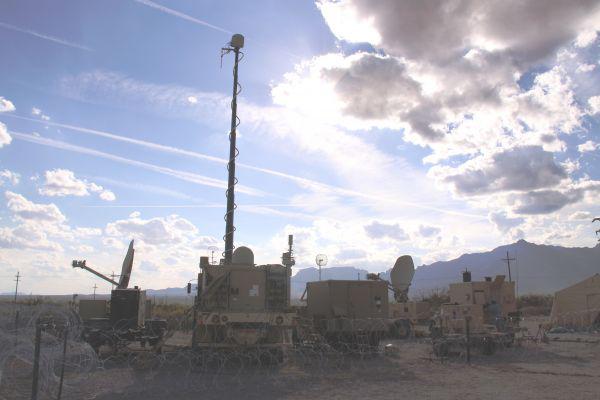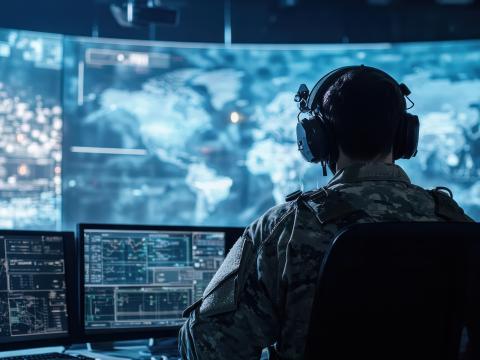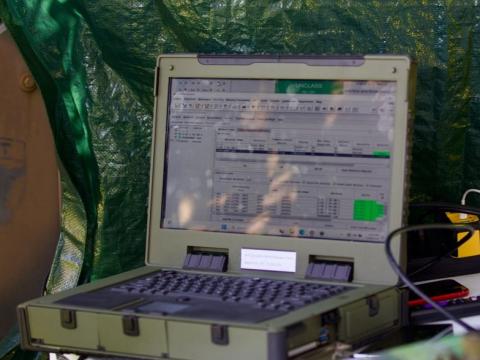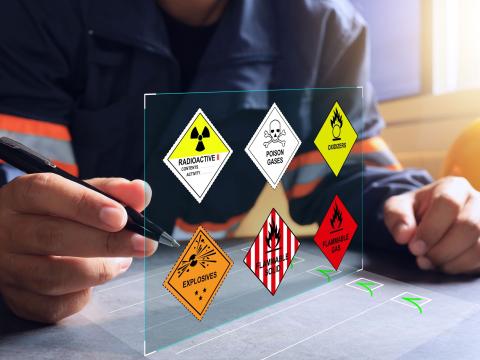U.S. Army Explores Push-Button Networking
The U.S. Army’s current tactical network delivers a wide range of capabilities for warfighters, including unprecedented communications on the move. But the complexity can overwhelm commanders who have countless critical tasks to complete and soldiers’ lives in their hands. Future tactical networks will automate many processes and may be smart enough to advise commanders, similar to JARVIS, Iron Man’s computerized assistant.
The Army’s current networking technology includes Capability Set 13, a package of network components, associated equipment and software that provides an integrated capability from the tactical operations center to the dismounted soldier. It supports Army warfighters in Afghanistan and provides a host of capabilities not offered by the wide area network in use as recently as 2012. The Army has fielded the capability set down to the company commander level with a package known as the Soldier Network Extension, which delivers some challenges along with the added capabilities. “The company commander is trying to maneuver around the battlefield, and he’s trying to command a company, and he has these new pieces of kit that he has to learn how to use, and it’s complicated. That’s part of the problem,” says Jennifer Zbozny, chief engineer for the Army Program Executive Office for Command, Control and Communications-Tactical. “If you had an iPhone with an interface you didn’t understand, and you had to do a million things and log on a million different ways, you’d probably get tired of it and decide it’s not worth the effort.”
A new, simplified version of the Soldier Network Extension will make an appearance at the service’s upcoming Network Integration Evaluation (NIE) and will be included with the next-generation network known as Network 2.0, Zbozny reports. “What’s going into NIE 15.1 is a much, much simpler version of the Soldier Network Extension. We believe it will go a long way in addressing the concerns we’ve gotten,” Zbozny offers.
Other challenges include jamming and communicating at the same time, finding more efficient ways to use limited spectrum, standardizing technologies and processes for networking with international partners, reassigning and reorganizing units, reducing redundant network operations tools, and reducing the size, weight, power and costs of network equipment, all while keeping the network secure. “There’s a lot of work underway to simplify the entire architecture and how we put that architecture together,” Zbozny relates.
Army officials envision three future networks that will progressively simplify matters for the warfighter. Network 2.0 will be fielded for the 2014 and 2015 fiscal period. The Simplified Tactical Army Reliable Network (STARNet) is being developed for the fiscal 2016-2020 time frame, and the Network after Next (NaN) will support warfighters in 2020 and beyond. The first focuses largely on simplification, the second on automation and the third on intelligent networking.
Officials are currently drawing up a road map to guide them toward the future vision of a robust, cost-effective, integrated solution that mimics the simplicity and capacity of commercial common networks. “A big focus area of Network 2.0, STARNet and NaN has to do with simplifying so that we can get to a push-button architecture. That’s the vision. I push a button, and everything works, just like I do on my iPhone. That’s really the road map that we’re trying to lay out,” Zbozny indicates, adding that officials have not yet set a date for completing the road map.
Each iteration of the network will feed the next. The approach is evolutionary, the results revolutionary, she says.
Part of the solution will be to provide a common interface at all levels and across platforms. Zbozny points out that many websites know whether a user is on a computer or a mobile device, and they will not push more information to the smaller device than the mobile network can handle. “The look and feel is the same, but it doesn’t offer you all of the options that you have on your computer,” she emphasizes. “I don’t need a manual because it’s easy to figure out, and I don’t need two different manuals for my iPhone and my computer. We want to get to a tactical computing environment where my handheld, my mounted and my tactical operations center systems really look to me to be the same, but they’re scaled appropriately to the network I have available.”
The network complexities affect more than company commanders. They also hamper unit task reorganization—the reassignment of a battalion or brigade, for example, to another unit. Along with Capability Set 13, the Army also fielded more than 1,000 data radios. When units are reorganized, the radios and a wide range of other network components must be reconfigured, a process that can take months. “You have all these data radios that nobody’s ever had before, and now when you have to move, say a company, from one battalion to another, you have to reconfigure all those radios. We didn’t have to do that before. So, we’re finding ways to do that over the air. We’re finding ways to automate that radio reconfiguration,” Zbozny reports.
Automation is, in fact, a key element for future networking. By the 2019 fiscal year, a commander may simply look at a screen and drag and drop the unit icon to where it needs to go. “Everything else behind it happens automagically,” Zbozny states, explaining that automation will make things appear to happen magically from the user perspective.
Automagic capabilities also will include systems that instantly hop from tactical to strategic to commercial networks, wherever bandwidth is available. Zbozny describes that level of automation as a pretty big deal. “Once we can do that, quite frankly, we ought to be able to connect to anything. If we can do it within a tactical unit, the strategic networks and the commercial networks are a little easier to fix,” she offers.
The complications of the modern military network reach beyond just the Army and even beyond the U.S. warfighter, and so do the Army’s ambitions for simplification. “Very often, there are NATO and other partners that we have to figure out how we communicate with. We’re trying to find a way to do it the same everywhere we go. We’ve tended, in the past, to do things specific to a theater, and now the intent is to have a seamless solution for that so that we can move forward the same way everywhere,” Zbozny reports.
The network is critical to the Army vision of a leaner, meaner, more efficient and effective fighting force able to adjust to any situation anywhere in the world. “We’re looking to develop adaptable solutions, to have our equipment adapt to different locations and different regions and different challenges that we’re going to face no matter where we are,” she declares. “We want to support all operational phases. We want to enable all echelons from the dismount all the way up to the brigade, division and above tactical operations centers. We want to support all regions and all partners.”
With NaN, that adaptability will likely include a degree of intelligent networking that Zbozny compares to JARVIS (Just A Rather Very Intelligent System) of Iron Man fame. “JARVIS is an intelligent assistant that recommends courses of action. You don’t have to do it, but sometimes it’s a good idea,” she says. “More intelligent networking, more aware network applications—all of those are really based on standards. We’re trying to get to a standardized network so we can enable all of this.”
The service also is converging network operations tools. Currently, many components are built with network operations capabilities included, but without regard to what similar tools might be included in other components. “What you end up with when you walk into a tactical operations center is a whole bunch of different tools that manage a single box and not a really good common operating picture,” Zbozny explains. The effort may reduce the number from 30 to three, she estimates. “It may never be just one, but even if you have three, the user can see a common operating picture that takes feeds from those three and shows him in one place the status of the network and what issues he may have,” she elaborates.
Additionally, the network operations convergence effort will provide cloud computing so that strategic-level echelons can take over some services once provided at the tactical level. “For those services you don’t have to provide locally, we’re starting to move some of those services out from the tactical unit up to the strategic network—the cloud, if you will—and have the tactical unit become a user instead of a provider of those services,” she states.
Additionally, tactical-level operators will be able to push cyber situational awareness data up the chain to the strategic level. Until recently, the Army Cyber Command has had very little visibility into tactical-level networks, she discloses. “We’re building that bridge to provide any information they need so that from their headquarters they can see what’s going on with the whole network.”





Comments